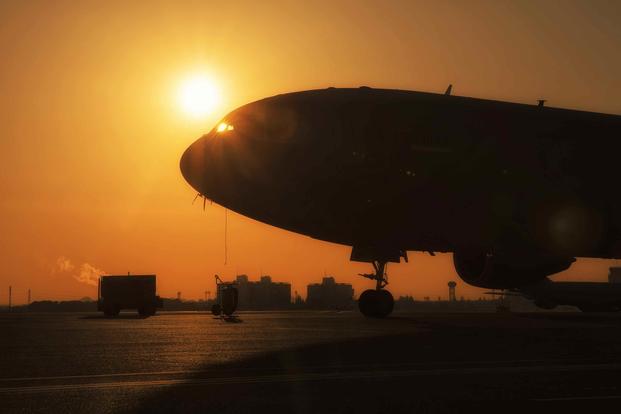Lawmakers are barring the U.S. Air Force from retiring any of its KC-135 Stratotanker refueling aircraft while the service struggles to get the KC-46 Pegasus up and running.
In its markup of the fiscal 2021 National Defense Authorization Act legislation, the House Armed Services Seapower and Projection Forces subcommittee said that the Air Force may not begin retiring any of its 379 Stratotankers until at least 2023. But it may start steady retirements of its KC-10 Extenders over the next three years, as long as it maintains a minimum requirement set by Congress.
Read Next: Soldier Used Upcoming Deployment to Plan Deadly Attack on Unit, Indictment States
The Senate Armed Services Committee version of the bill, published Tuesday, also pushes back the divestment of legacy tankers.
In its 2021 budget request, the Air Force proposed retiring 13 KC-135s and 16 KC-10 refuelers.
House and Senate lawmakers set a minimum for the KC-10 as well: The Air Force must maintain 50 primary mission KC-10A aircraft in fiscal 2021; 38 in fiscal 2022; and 26 in fiscal 2023, according to the legislation. The Air Force currently has 59 KC-10s, 56 of which are considered primary mission tankers.
As for the KC-135 fleet, the Air Force can retire 14 starting in 2023, according to the Senate version of the bill.
As part of a larger strategy, defense officials have said they no longer want to kick the can down the road on aging aircraft -- especially over-deployed tankers and bombers -- that may not be suitable for a fight against a near-peer adversary such as China or Russia. The service has said it wants to avoid major overhauls for some of these aircraft just to keep less-than-capable fleets afloat.
The reductions, Air Force officials have said, are necessary as the service looks to invest in newer aircraft or technologies by reallocating resources in a more efficient way.
However, some top brass have been concerned about tanker capacity shortfalls, given persistent issues with the KC-46 Pegasus.
In February, Army Gen. Stephen Lyons, head of U.S. Transportation Command, called on the Air Force to slow the retirement of more than 20 aerial refueling tankers slated to be cut, saying doing so is necessary to reduce stress on overtasked aircrews while the service works with Boeing Co. to fix the KC-46. The Pegasus has had numerous problems, including how its boom connects and disconnects from other aircraft; foreign object debris, such as trash, tools, nuts and bolts, found scattered inside multiple planes; and a glitch in its Remote Vision System (RVS) software.
Currently, the RVS glitch doesn't allow an airman to look at a clear, aligned visual of the boom connecting to another aircraft. The first tankers were delivered to the Air Force in 2019 despite that problem.
Lawmakers have taken note. According to the legislation, the House subcommittee recommended that the Air Force slow the KC-46A procurement "to the minimum sustaining rate to minimize the number of aircraft that will require modification of the Remote Vision System given the Remote Vision System 2.0 is still in development."
Air Force Chief of Staff Gen. David Goldfein told lawmakers in March that the service has been working with Boeing, "targeting the [2023/2024] timeframe to have a fix in place."
His comments revealed that the tanker's expected readiness has been pushed back at least a year. Last year, Gen. Maryanne Miller, head of Air Mobility Command, said the tanker would likely be fully ready to deploy to a combat zone sometime in 2022.
The service also intends to downsize its B-1B Lancer bomber fleet by 17 aircraft. It currently has 61.
The House subcommittee said it will allow the bomber retirements as long as the service keeps 24 combat-coded aircraft; lawmakers previously stipulated the service keep at least 36 bombers always ready for combat.
The B-1B fleet has been undergoing extensive maintenance for the past few months after the service overcommitted its only supersonic heavy payload bomber to operations in the Middle East over the last decade. The repeated deployments caused the aircraft to deteriorate more quickly than expected, Gen. Tim Ray, head of Air Force Global Strike Command (AFGSC), said last year.
"We still think it's the right move to make, where we take the 17 airplanes that require the most structural work and, rather than spend the money to repair those, we take that money savings and roll it back into" other programs, Maj. Gen. Jim Dawkins Jr., commander of the Eighth Air Force and the Joint-Global Strike Operations Center at Barksdale Air Force Base, Louisiana, told Military.com last month. It would mean the service reduces its overall Lancer fleet to just 44 aircraft.
"Or to have [fewer] airplanes to take care of for our maintainers," Dawkins said.
-- Oriana Pawlyk can be reached at oriana.pawlyk@military.com. Follow her on Twitter at @Oriana0214.
Related: House Lawmakers Add Roadblocks to Air Force's Planned Global Hawk Retirements












